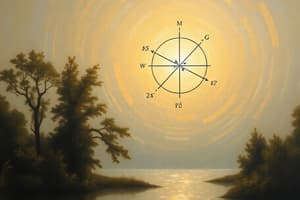Podcast
Questions and Answers
If the circumference of a circle is $\pi d$, and the radius is $r$, what is the expression for the circumference in terms of $r$?
If the circumference of a circle is $\pi d$, and the radius is $r$, what is the expression for the circumference in terms of $r$?
- $\pi r^2$
- $4\pi r$
- $\pi r^3$
- $2\pi r$ (correct)
If the area of a circle is $\pi r^2$, and the circumference is $C$, what is the expression for the area in terms of $C$?
If the area of a circle is $\pi r^2$, and the circumference is $C$, what is the expression for the area in terms of $C$?
- $C^2 / (\pi)$
- $C^2 / (16\pi)$
- $C^2 / (4\pi)$ (correct)
- $C^2 / (8\pi)$
If the arc length of a circle is $\theta r$, where $\theta$ is the angle in radians, which of the following expressions represents the arc length in terms of the circumference $C$?
If the arc length of a circle is $\theta r$, where $\theta$ is the angle in radians, which of the following expressions represents the arc length in terms of the circumference $C$?
- $\theta C / (2\pi)$ (correct)
- $\theta C / \pi$
- $\theta C / (4\pi)$
- $\theta C / (8\pi)$
If the diameter of a circle is $d$, and the circumference is $C$, what is the expression for the radius $r$ in terms of $C$?
If the diameter of a circle is $d$, and the circumference is $C$, what is the expression for the radius $r$ in terms of $C$?
If the area of a circle is $A$, and the circumference is $C$, what is the expression for the diameter $d$ in terms of $A$ and $C$?
If the area of a circle is $A$, and the circumference is $C$, what is the expression for the diameter $d$ in terms of $A$ and $C$?
Which formula should be used to calculate the circumference of a circle given its radius?
Which formula should be used to calculate the circumference of a circle given its radius?
What is the relationship between the radius and the diameter of a circle?
What is the relationship between the radius and the diameter of a circle?
If the area of a circle is doubled, what happens to its radius?
If the area of a circle is doubled, what happens to its radius?
Given a circle with a circumference of 10π units, what is its diameter?
Given a circle with a circumference of 10π units, what is its diameter?
If the arc length of a circle with a central angle of 90 degrees and a diameter of 8 units is calculated, what would be the result?
If the arc length of a circle with a central angle of 90 degrees and a diameter of 8 units is calculated, what would be the result?
Flashcards are hidden until you start studying
Study Notes
Circles
A circle is a simple geometric figure consisting of all points located at equal distance from its center. It has various properties related to its shape and measurements, which are essential in mathematics and physics.
Circumference
The circumference of a circle is the total distance around its perimeter. To find the circumference of a circle, you can use the formula C = πd, where C represents the circumference and d stands for the diameter of the circle. This equation essentially states that the circumference is dependent on the diameter of the circle, with pi being a constant factor. By knowing either the diameter or circumference, you can calculate the other.
Arc Length
Arc length refers to the distance along a circular path measured between two points on the circumference. To find the length of an arc, you need to know its degree measure, the radius of the circle, and the central angle (angle subtended by the arc at the center of the circle). The formula for arc length is l = D * θ/360, where l represents the arc length, D stands for the diameter of the circle, and θ is the central angle.
Area
The area of a circle is the region enclosed by its boundary, i.e., the circle's circumference. In mathematical terms, the area of a circle is calculated using the formula A = πr^2, where A represents the area and r stands for the radius of the circle. This formula shows that the area of a circle is proportional to the square of its radius, and pi is a constant factor.
Radius
The radius of a circle is the distance from the center of the circle to any point on its edge. It is half the diameter of the circle and can be found by dividing the diameter by 2. The radius is a critical component in finding the circumference, arc length, and area of a circle.
Diameter
The diameter of a circle is the distance across the circle from one edge to the opposite edge, passing through the center of the circle. It is twice the radius of the circle. The diameter is used to calculate the circumference of a circle using the formula C = πd, where C represents the circumference and d stands for the diameter of the circle.
In summary, circles have essential properties that are measured by circumference, arc length, area, radius, and diameter. These properties are interconnected and can be used to calculate each other with the appropriate formulas. Understanding these properties and their relationships is crucial for various mathematical and scientific applications.
Studying That Suits You
Use AI to generate personalized quizzes and flashcards to suit your learning preferences.




